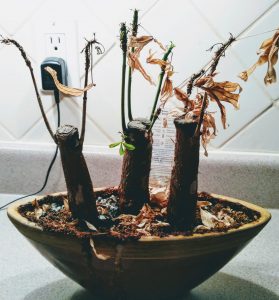
Hi,
I’m from a zone 5 neighborhood in Ajax, and I’m experiencing a lot of difficulties with my bonsai that can’t seem to decide whether it wants to live or die, though I’d kinda like it if it lived.
It’s been in the state pictured below for a few years now and I’ve tried everything I can think of except repotting it, which is my last idea. I’ve changed it’s spot around my house for different lighting conditions, increased and decreased watering schedule, amount of water given, fertilizer used (all purpose Miracle Gro & liquid all purpose plant food), and nothing’s worked at all.
That’s why I decided you to message you today to request you for your advice in this matter. I would really appreciate your help with making my plant recover from whatever is wrong with it.
Thank you,
M
Your bonsai are grafted, a technique usually used to grow bonsai that are difficult to start from seed like Japanese White pine (Pinus parviflora) or that do not grow as vigorously as the stock they are grafted onto. For example, some slower growing maples are grafted onto Acer palmatum for this reason and citrus trees are also often grafted. If the graft takes, the scion (the top piece grafted into the stronger root stock) should sprout within 6 months.
To grow bonsai indoors it should be a tropical or subtropical plant that can tolerate indoor warmth all year round. Citrus trees are a good example. See this link to our bonsai growing guide for some general information about growing bonsai.
The small green leaves showing in the photo look as though they are sprouting from the root stock, not the scion. If this is the case and there are no leaves on the scion it means the graft has not taken and you should discard the bonsai.
If there are leaves on the scion then it would be a good idea to repot it since you have had it for 2 years in the same soil. This will give you a chance to assess the health of the roots. Gently remove the plant and check the root ball. A healthy root ball should have lots of fine root hairs and there should be some space between the roots for soil and air. If there is too little soil it is root bound and it will dry out too quickly. Another sign of being root bound is if roots are coming through the drainage hole or if the roots inside the container are massed and circling the interior. A broad leaf plant like yours requires a soil that will hold the water but your container should drain well so the plant dose not sit in soggy soil. Is the root ball really wet or is it really dry? Often the symptoms of over watering are the same as for under watering. If you make your own mix try 1/4 sand:1/4 leaf mold:1/2 earth or buy a prepared mix for bonsai broad leaf plants.
When adding fertilizer try using organic fertilizer liquids such as kelp extract as they can provide micro nutrients that may not be in the inorganic fertilizer. Make sure you do not over fertilize in an effort to cure what ails the plant. It is better to apply a more frequent, weaker solution of fertilizer than a single stronger solution.
Light is essential for photosynthesis. Bonsai should be grown in full sun in early summer but may require some shading under strong midsummer sun. Remember also that this is a particular type of tree that you are growing and different trees have varying needs. What works for one bonsai tree, an evergreen for example may not work for another such as a tropical citrus tree or a delicate Japanese maple.

